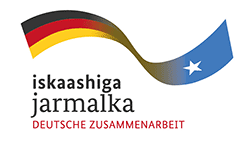Installing solar panels at Prof Adow TVET center, Galkayo
One-year modules. Three year qualified craftsman education.
Technical Vocational Education and Training (TVET) system in Somalia was not well developed before the civil war, with only a few TVET institutions in Mogadishu, Burao and Hargeisa specialized in technical courses and traditional trades at craft and artisan levels. Most of these institutions were, however, destroyed or run down during the long period of civil war. The TVET system in Somalia faces challenges such as:- outdated structure and curriculum;
- lack of administrative skills for vocational training centres;
- lack of training skills of TVET trainers; and
- aging facilities and equipment of TVET centres.
Only 45% of Somali youth can read and write (49% of males, 41% of females). Around 69% of youth are not currently enrolled in school.
Modular based educational system
The core of the TVET+ network will be the NGO-managed Professor Adow training centre in Galkayo which was founded in 2013 with financial support from the Norwegian ministry of Foreign Affairs and support from the Norwegian-Somali diaspora. It has been built following the example of other Yme-supported training centres in Mozambique and Rwanda with adapted curricula from Entembeni Technical School in South Africa. This TVET concept comprises of two fundamental principles, which have been thoroughly implemented, tested and refined by the Yme Foundation and its partners over the past 12 years in post-conflict or conflict contexts in Rwanda, Congo DRC, Mozambique and Somalia:- Module-based classes and training
Module-based teaching ensures students are all vetted before they start working. The comprehensive training and thorough assessment program are one of the most important reasons why this concept enjoys a high degree of credibility among private businesses and employers as they know the students come with a recognized "stamp of approval".
- Built-in assessment procedures to ensure students meet a predefined set of competencies and skills before graduating from a module and advancing to the next level.
The experience from schools in Mozambique, Rwanda, DR Congo and Galkayo has shown that all the schools have one common denominator of getting students quickly into secure jobs. They also experience very few dropouts, and more than 95% of the students get a job in the formal or informal job market after graduating from the schools above.
The module-based training and method also benefits from constant engagement and cooperation with the private sector, which is essential for future employment, after completing the courses. The private sector also greatly benefits from the training: Students that graduate with quality TVET education will become important players in building and strengthening the private sector as the quality of services and products delivered by companies and entrepreneurs in the region will improve. Finally, by providing skills training of high standard the youth will not only gain technical skills, but also basic numeric and literacy skills. Perhaps more importantly, through being in a class setting within a classroom structure, they will learn important life skills such as collaboration, respect and teamwork. Having a gendered approach in the schools will ensure that both the needs of women and men are met. These offered skills are needed for promoting sustained economic growth and social development in Somalia.
Three year Qualified Craftsman
The three year craftmannship learner is based on the Competency Based Modular Training (CBMT) system, meaning that the student must pass the modular and phase tests. In addition they must pass the final trade test to be recognized as an artisan. The Learnerships are outcome-based, hence if the students can demonstrate their competencies during assessment, they receive the qualification or credits required to graduate.The learners must complete every training module and pass the relevant module test. Once they have passed the module the learner can continue to the next module or phase of the training. The training is structured and the qualification will be nationally recognized.

Submenu
Stay informed
Enter your email address to receive updates from TVET+ delivered to your inbox.













